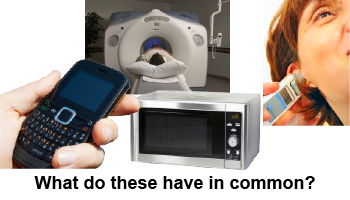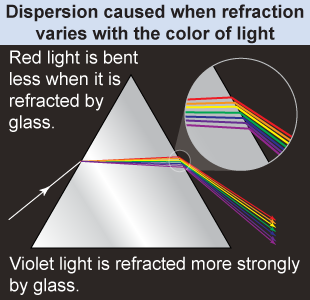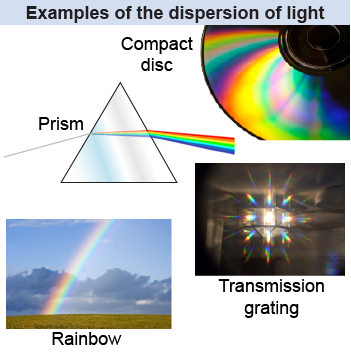|
 What do a medical PET scanner, a mobile phone, an ear thermometer, and a microwave oven have in common? The answer is that all three technologies use regions of the electromagnetic spectrum. The PET scanner uses high energy gamma rays, the ear thermometer uses infrared or thermal radiation, and the oven and mobile phone both use microwaves. Gamma rays, infrared radiation, and microwaves are types of “light,” differing from the light we see (and from each other) in frequency, wavelength, and energy.
What do a medical PET scanner, a mobile phone, an ear thermometer, and a microwave oven have in common? The answer is that all three technologies use regions of the electromagnetic spectrum. The PET scanner uses high energy gamma rays, the ear thermometer uses infrared or thermal radiation, and the oven and mobile phone both use microwaves. Gamma rays, infrared radiation, and microwaves are types of “light,” differing from the light we see (and from each other) in frequency, wavelength, and energy. 
|
Dispersion of light
|
When you look at a rainbow, you see sunlight separated into red, orange, yellow, and so on. Dispersion is the separation of light into its constituent colors or wavelengths. Dispersion in a rainbow is caused by refraction. The water droplets that cause a rainbow refract blue light slightly more than red light, so your eyes see blue and red in a slightly different place. 
|
 The diagram on the right shows how different colors diffract different amounts through an imaginary prism. The index of refraction for crown glass is n = 1.513 for red light, but it is slightly larger, n = 1.532, for violet light. The index varies between 1.513 and 1.532 as the color changes from red through violet. The higher value of n for violet light means that violet light is refracted more than red light. In the illustration at right, the violet light rays are bent the most, emerging from the prism at the bottom. Red rays are bent the least. Intermediate colors are bent at angles in between red and violet.
The diagram on the right shows how different colors diffract different amounts through an imaginary prism. The index of refraction for crown glass is n = 1.513 for red light, but it is slightly larger, n = 1.532, for violet light. The index varies between 1.513 and 1.532 as the color changes from red through violet. The higher value of n for violet light means that violet light is refracted more than red light. In the illustration at right, the violet light rays are bent the most, emerging from the prism at the bottom. Red rays are bent the least. Intermediate colors are bent at angles in between red and violet. 
 |
An actual experiment that disperses light through a prism is difficult to set up and does not look like this! First, the white beam cannot be seen from the side, nor can the colored beams without something to scatter the light sideways. Second, most white light contains smoothly varying colors, not seven monochromatic beams as shown in the diagram. Last, it takes a very bright source and a narrow beam to get good dispersion. Newton observed this with bright sunlight by making a beam using two slits in boards separated by a distance. He allowed the light to fall on a far wall in a darkened room and observed the dispersed colors on the wall. 
|
 There are many examples of the dispersion of light all around you. Four are shown in the illustration on the right. Later in this chapter you will learn the physics behind each one of these examples. The prism and rainbow are both based on the refraction of light as it passes from one medium to another—into glass for the prism or water for the rainbow. The compact disc is a reflection diffraction grating, while the novelty Rainbow Peepholes™ contain a transmission diffraction grating. Diffraction gratings have thousands of tiny, repeating grooves or rulings that break light up into many independent beams that interfere with each other to create dispersion.
There are many examples of the dispersion of light all around you. Four are shown in the illustration on the right. Later in this chapter you will learn the physics behind each one of these examples. The prism and rainbow are both based on the refraction of light as it passes from one medium to another—into glass for the prism or water for the rainbow. The compact disc is a reflection diffraction grating, while the novelty Rainbow Peepholes™ contain a transmission diffraction grating. Diffraction gratings have thousands of tiny, repeating grooves or rulings that break light up into many independent beams that interfere with each other to create dispersion. 
|
| |
|

